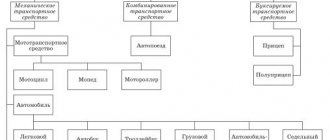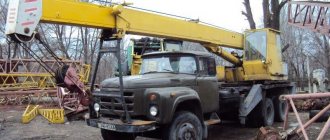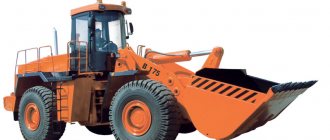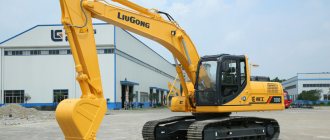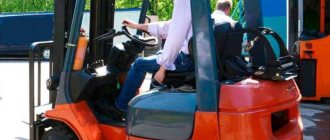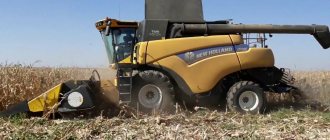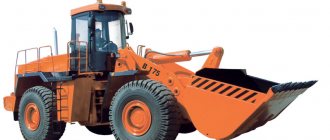Work of the company Equipment for Warehouse in April 2020
We increase the capacity of your warehouse by 50%
LEMA towers with a 10% discount!
LemaZowell self-propelled stackers are 15% cheaper!
Up to 50% discount on trolley wheels
Pallet racks from 1037 rub. per pallet space
According to Art. 258 of the Tax Code of the Russian Federation, additionally taking into account the classification of fixed assets (classification approved by Government Decree No. 1 of 01/01/2002) when introducing fixed assets (fixed assets) into use, the taxpayer sets their useful life independently. The depreciation group of fixed assets is determined in accordance with their useful life.
Useful life of a depreciation group
When establishing the useful life for various types of warehouse equipment, you can use the appropriate codes:
for stackers, OKOF code 14 2921030 /3/ can be used, - “loading and unloading equipment and machinery, equipment for laboratories, transport and agricultural equipment”, which corresponds to code 14 2921030 of the classification of fixed assets in the section “Machinery and Equipment”, this is the third depreciation group (property that has a useful life of more than 3 - 5 years, including this period);
for electric forklifts - OKOF 15 3599030 /9/ can be used - “in-house transport vehicles based on electric traction (electric cars, electric carts, electric forklifts, etc.), which correspond to code 15 3599301 “electric forklifts” of the classification of fixed assets in the section “Vehicles” , this is the third depreciation group (property that has a useful life of 3 - 5 years including this period).
Attention! The sequence of operations when determining the useful life, as a rule, is fixed in the accounting policy of the organization, since it is its integral component.
OKOF 330.28.92.26.110 – Self-propelled single-bucket excavators
OKOF 330.28.92.26.110 – Self-propelled single-bucket excavators
- OKOF - All-Russian Classifier of Fixed Assets
- 300.00.00.00.000 - Machinery and equipment, including household equipment, and other objects
- 330.00.00.00.000 - Other machinery and equipment, including household equipment, and other objects
- 330.28 - Machinery and equipment not included in other groups
- 330.28.9 — Other special-purpose equipment
- 330.28.92 - Equipment for underground and open-pit mining and construction
- 330.28.92.2 - Other machines for moving, grading, leveling, scraping, excavating, compacting, compacting or mining, self-propelled, for soil, minerals or ores (including bulldozers, excavators and road rollers)
- 330.28.92.26 — Single-bucket excavators and self-propelled bucket loaders with a 360° cab rotation (full-rotary machines), except for single-bucket front loaders
- 330.28.92.26.110 — Self-propelled single-bucket excavators
330.28.92.26.110 — Self-propelled single-bucket excavators
Classifier: OKOF OK 013-2014 Code: 330.28.92.26.110 Name: Self-propelled single-bucket excavators Subsidiary elements: 0 Depreciation groups: 1 Direct adapter keys: 4
Subgroups
Grouping 330.28.92.26.110 in OKOF is final and does not contain subgroups.
Shock absorption groups
In the classification of fixed assets included in depreciation groups, code 330.28.92.26.110 is listed in the following groups:
| Group | Subgroup | Deadlines | Note |
| Fourth group | cars and equipment | property with a useful life of over 5 years up to 7 years inclusive | — |
Transition keys
To move from the old OKOF to the new OKOF, use a direct transition key:
| OKOF OK 013-94 | OKOF OK 013-2014 | ||
| Code | Name | Code | Name |
| 142924152 | Single-bucket excavators with a bucket capacity of 4 cubic meters. m and above | 330.28.92.26.110 | Self-propelled single-bucket excavators |
| 142924331 | Single-bucket crawler excavators | ||
| 142924332 | Single-bucket excavators with pneumatic wheels | ||
| 142924333 | Single-bucket excavators with wide caterpillar tracks | ||
© 2022 okof2.ru - All-Russian classifier of fixed assets with decoding and search
Classifier of fixed assets. What changed?
Fixed assets (FPE) of an organization, depending on their useful life (SPI), for profit tax purposes are assigned to one or another depreciation group (Clause 1, Article 258 of the Tax Code of the Russian Federation). The useful life of the OS is determined by the organization itself, taking into account the classification approved by Decree of the Government of the Russian Federation of January 1, 2002 No. 1 (Resolution No. 1).
In 2022, all depreciation classification groups have changed, except the first. The changes apply to legal relations arising from January 1, 2022.
Most of the amendments are in the subsection “Structures and transmission devices” of the second to tenth groups. The list of fixed assets in the “Machinery and Equipment” subsection of the second and ninth groups has been expanded.
Classifier of fixed assets by depreciation groups with examples of fixed assets:
The All-Russian Classifier of Fixed Assets (OKOF), which determines the depreciation group of fixed assets, remains unchanged. Since January 1, 2017, OKOF OK 013-2014 (SNS 2008), approved by Rosstandart order No. 2018-st dated December 12, 2014, has been in effect. The same classifier will be in effect in 2022.
Which shock-absorbing group does a front loader belong to?
Good afternoon We purchase an XCMG LW300FN front loader under a leasing agreement. A suitable frame for this position is 3330.28.92.25 - Self-propelled single-bucket front loaders, do not belong to any shock-absorbing group. The lessor, if the asset is placed on its balance sheet, plans to classify it as the 9th depreciation group, probably guided by the Decree of the Government of the Russian Federation of January 1, 2002 No. 1 “On the classification of fixed assets included in depreciation groups”, there is such a position 330.28. 92 Equipment for underground and open-pit mining and construction with a note - dredges (complex mechanized mining and processing unit), which is completely unsuitable for this operating system. Leasing referred to the auditor’s response that the loaders are now classified as 9th Am. Group. A similar question has already been raised on the forum, where the 4th American group was considered, which includes loaders, EXCEPT front-end single-bucket loaders, i.e. also not suitable. I found on other sites (old articles, still with old frames) that these loaders belong to the 5th American group, but without any special justification. Question: maybe someone in the near future will take into account a similar OS and has information with justification to which am. group the front loader belongs. Help me please. I will be grateful for your answer
How to determine the useful life of an OS
Stage 1 - establish the depreciation group of the fixed asset according to the classification approved by Resolution No. 1
The classification of fixed assets is a table in which, for each depreciation group, the names of the fixed assets included in it and the corresponding codes of the All-Russian Classifier of Fixed Assets are listed.
For tax accounting purposes, according to the classification of fixed assets, the following is determined:
- depreciation group to which the fixed asset belongs. All depreciable property is combined into 10 depreciation groups depending on the useful life of the property (clause 3 of Article 258 of the Tax Code of the Russian Federation). Depreciation groups are also important in determining the amount of depreciation bonus that can be applied to a specific asset;
- the useful life must be within the limits established for each depreciation group (Letter of the Ministry of Finance of Russia dated July 6, 2016 No. 03-05-05-01/39563). Choose any period within the SPI, for example the shortest, in order to quickly write off the cost of the fixed assets as expenses (Letter of the Ministry of Finance of the Russian Federation dated July 6, 2016 No. 03-05-05-01/39563).
You can set an entire OS group in the classification. A transcript of the group is presented in OKOF.
Define the depreciation group of the fixed asset as follows:
- In the first column of OKOF, find the type of property to which the OS belongs (9 digits).
- Check the code specified in the OKOF in the first column of the OS classification.
- If there is a code in the OS classification, look at which depreciation group the OS belongs to.
OKOF 330.28.22.15.120 – Other loaders
OKOF 330.28.22.15.120 – Other loaders
- OKOF - All-Russian Classifier of Fixed Assets
- 300.00.00.00.000 - Machinery and equipment, including household equipment, and other objects
- 330.00.00.00.000 - Other machinery and equipment, including household equipment, and other objects
- 330.28 - Machinery and equipment not included in other groups
- 330.28.2 - Other general purpose machinery and equipment
- 330.28.22.1 — Lifting and transport equipment
- 330.28.22.15 - Forklifts, other loaders; tractors used on railway station platforms
- 330.28.22.15.120 — Other loaders
330.28.22.15.120 — Other loaders
Classifier: OKOF OK 013-2014 Code: 330.28.22.15.120 Name: Other loaders Subsidiary elements: 0 Depreciation groups: 1 Direct adapter keys: 8
Is a forklift a primary asset?
According to paragraph 1 of Art. 256, paragraph 1, art. 257 of the Tax Code of the Russian Federation, property is recognized as a depreciable item of fixed assets if:
- is owned by the taxpayer;
- used to generate income as means of labor for the production and sale of goods (performance of work, provision of services) or to manage an organization;
- its cost is repaid by depreciation;
- its useful life is more than 12 months, and the initial cost is more than 40,000 rubles.
The forklift fully meets the listed criteria. The possibility of classifying it as a fixed asset is also confirmed by the fact that forklifts are subject to classification in OKOF. They are included in the subsection “Machinery and Equipment” (code 14 0000000) under code 14 2915540. In addition, in the Classification of fixed assets included in depreciation groups, taking into account which taxpayers determine the useful life of fixed assets, forklifts are classified in the fourth depreciation group . This group includes property with a useful life of more than five to seven years inclusive.
Rationale
The 4th group of fixed assets includes (Classification of fixed assets included in depreciation groups):
From 01/01/2017
Until 01/01/1017
Code OKOF 14 2915070 Other lifting and transport equipment (forklifts). This class of fixed assets includes the following types:
14 2915070 Other lifting and transport equipment
14 2915540 Forklifts
14 2915541 Forklifts for loading and unloading and stacking long cargo
14 2915542 Special forklifts
14 2915549 Other forklifts
An example from judicial practice
The agricultural forklift Manitou Maniscopic MLT-X 735 T LSU belongs to the 4th depreciation group (Resolution of the Arbitration Court of the West Siberian District dated 01.08.2017 N F04-2570/2017 in case N A70-12797/2016, Resolution of the Supreme Court of the Russian Federation dated 25.10 .2017 N 304-KG17-15109 refused to be transferred to the Judicial Collegium for Economic Disputes of the RF Armed Forces)
When does depreciation start?
According to paragraph 1 of Art. 258 of the Tax Code of the Russian Federation, in accordance with the established useful lives, depreciable property is distributed into depreciation groups. In this case, the useful life is determined by the taxpayer independently on the date of commissioning of the relevant facility. Thus, the forklift is included in the fourth depreciation group on the date of its commissioning. From the 1st day of the month following the month in which the object was put into operation (included in the corresponding depreciation group), depreciation begins to be calculated (clause 4 of Article 259 of the Tax Code of the Russian Federation).
Please note that clause 11 of Art. does not apply to a forklift. 258 of the Tax Code of the Russian Federation, according to which fixed assets, the rights to which are subject to state registration under the legislation of the Russian Federation, are included in the corresponding depreciation group from the moment of the documented fact of filing documents for registration of these rights. We are talking about state registration of rights to property. By virtue of Art. 131 of the Civil Code of the Russian Federation, rights to real estate are subject to state registration. As for rights to movable property, they do not need to be registered, except in cases specified in the law. The law does not require registering a transaction with a forklift. At the same time, it is necessary to remember: the forklift itself (the working volume of the internal combustion engine of which is more than 50 cubic cm (0.05 l)), despite the fact that it is not intended for driving on public roads, is subject to state registration with the authorities Gostekhnadzor during the validity period of the “Transit” registration plate or five days after acquisition, customs clearance, deregistration, replacement of license plate units or the occurrence of other circumstances requiring changes to the registration data. This requirement is established by Decree of the Government of the Russian Federation of August 12, 1994 N 938 “On state registration of motor vehicles and other types of self-propelled equipment on the territory of the Russian Federation.”
Depreciation groups of vehicles
Motor vehicles, in accordance with the Classification of fixed assets, are classified into III-V depreciation groups. Let us recall that the SPI for them is set as follows:
- III - over 3 to 5 years inclusive;
- IV - over 5 to 7 years inclusive;
- V - over 7 to 10 years inclusive.
Here are examples of vehicles classified in these groups:
| Depreciation group | Name of the vehicle |
| III | Passenger cars (with an engine capacity of no more than 3.5 liters); Buses are especially small and small, up to 7.5 m long inclusive; Trucks with a diesel or gasoline engine, having a technically permissible maximum weight of not more than 3.5 tons |
| IV | Small class passenger cars for disabled people; Extra large city buses (bus trains) with a length of over 16.5 to 24 m inclusive; Long distance buses; Buses are medium and large, up to 12 m long inclusive; Trucks, road tractors for semi-trailers (general purpose vehicles: flatbeds, vans, tractors; dump trucks); Hearses; Concrete trucks; Timber trucks; Vehicles for public utilities and road maintenance |
| V | Large class passenger cars (with engine displacement over 3.5 liters) and high class; Other especially large buses (bus trains) with a length of over 16.5 to 24 m inclusive; Trucks with a diesel engine having a technically permissible maximum weight of over 3.5 tons; Truck tractors; Automotive hydraulic lifts; Garbage trucks |
If the vehicle falls into one of these groups, then the organization determines the SPI within the period provided for the corresponding group. For example, for a passenger car with an engine capacity of over 3.5 liters, the SPI can be set from 85 months to 120 months inclusive.
And, for example, what is the depreciation group for a car crane?
The truck crane is located in the “Vehicles” section with code 310.29.10.51. According to the Tax Classification, special-purpose motor vehicles with code according to OKOF 310.29.10.5 are assigned to depreciation groups IV and V. Therefore, an organization can independently classify a truck crane into any of these groups. Please note that in addition to truck cranes, the Classification also contains mention of other cranes that are not classified as vehicles. Thus, lifting cranes are generally assigned to depreciation group VII (SPI over 15 to 20 years inclusive). Also in certain groups of the Classification you can find other references to cranes. Thus, boom-type lifting cranes are classified in accordance with the Classification as depreciation group II (SPI over 2 to 3 years inclusive), and derrick cranes, hoisting cranes, portal cranes, self-propelled or non-self-propelled vehicles equipped with a crane - to depreciation group III (SPI over 3 to 5 years inclusive). Other self-propelled machines and trolleys equipped with a crane, not included in other groups, belong to depreciation group IV (SPI over 5 to 7 years inclusive). Thus, the shock-absorbing group of a truck crane, depending on its type, can be installed from those proposed above.
Electric forklifts and stackers are “warehouse” self-propelled equipment, a mandatory attribute of any modern warehouse. For accounting and tax accounting purposes, in accordance with PBU 6/01 and the Tax Code of the Russian Federation, this equipment is depreciable property and is classified as fixed assets of organizations.
Features of accounting and taxation of self-propelled equipment raise many questions among accountants. In what cases should equipment be registered with government agencies? To pay or not to pay transport tax? What are the tax consequences of not having state registration of self-propelled vehicles?
In this article we will try to answer the most important of these questions.
1. Selecting a shock-absorbing group for electric forklifts and stackers
When putting into operation fixed assets (hereinafter referred to as fixed assets), in accordance with Art. 258 of the Tax Code and taking into account the OS classification (approved by Decree of the Government of the Russian Federation No. 1 of 01/01/2002), the taxpayer independently establishes the useful life (hereinafter referred to as the SPI) of the object. In accordance with the established SPI, the depreciation group of the fixed assets is determined.
In our opinion, when establishing SPI for “warehouse equipment” the following codes can be used:
- for stackers
- OKOF code
14 2921030
/3/ “machinery and equipment for loading and unloading, transport, laboratory equipment for agriculture”, corresponding to code
14 2921030
of the OS classification of the section “Machinery and Equipment” and the third depreciation group (property with SPI over 3 years up to 5 years inclusive); - for electric forklifts
- code OKOF
15 3599030
/9/ “intra-facility transport vehicles with electric traction (electric vehicles, electric forklifts, electric carts and others), corresponding to code
15 3599301
“electric forklifts” of the OS classification section “Transport vehicles” and the third depreciation group (property with SPI over 3 years to 5 years inclusive).
Please note: the procedure for determining SPI must be enshrined in the accounting policies of the organization.
This is a mandatory element. 2. The procedure for registering self-propelled vehicles with government agencies
So what equipment is subject to registration with government agencies? Let's turn to the current legislation.
Decree of the Government of the Russian Federation No. 938 of August 12, 1994. (hereinafter referred to as Resolution No. 938) established that self-propelled road construction machines and other machines
with an internal combustion engine displacement of more than 50 cc.
or a maximum electric motor power of more than 4 kW
, owned by legal entities and individuals (extract from paragraph 1 of Resolution No. 938).
Thus, we must turn to the technical documentation for self-propelled equipment and find out the power of the electric motor of each piece of equipment.
Unfortunately, it is not uncommon for the accounting department to have no documents for equipment other than the delivery note and invoice. How to be? It is necessary to make a request to provide a technical passport for the equipment to the department responsible for the storage and operation of self-propelled equipment. If this document is lost, you will have to contact the manufacturer for its restoration. Also, the necessary information about the capacity of the company’s equipment can be provided by the equipment supplier if the equipment was purchased through a trade organization and not at the factory.
So, we have found out the power of our self-propelled vehicles. Further we will talk only about the equipment that is subject to state registration, i.e. whose power exceeds 4 kW.
Which government body registers self-propelled vehicles whose power exceeds 4 kW?
In accordance with paragraph 2 of Resolution No. 938, registration of self-propelled equipment is carried out by state supervision authorities over the technical condition of self-propelled vehicles and other types of equipment in the Russian Federation (hereinafter referred to as state technical supervision authorities).
For registered self-propelled vehicles, state technical supervision authorities issue documents confirming the state registration of self-propelled vehicles, as well as state registration plates.
Time limits for state registration by owners of self-propelled vehicles.
Owners of self-propelled vehicles must register them with the state technical supervision authorities during the validity period of the “Transit” registration plate or within five days after the acquisition and customs clearance of self-propelled vehicles (excerpt from paragraph 3 of Resolution No. 938).
Please note: legal entities and individual entrepreneurs who trade in vehicles in the manner prescribed by the legislation of the Russian Federation do not register vehicles intended for sale
.
Registration of self-propelled vehicles with the state technical supervision authority is carried out on the basis of passports of self-propelled vehicles, as well as concluded agreements or other documents certifying ownership of the equipment and confirming the possibility of allowing them to operate on the territory of the Russian Federation (excerpt from clause 4 of Resolution No. 938).
Passports of self-propelled vehicles produced on the territory of the Russian Federation are issued by manufacturers (clause 2 of the Decree of the Government of the Russian Federation No. 460 of May 15, 1995)
Passports of self-propelled vehicles imported into the territory of the Russian Federation have been issued by customs authorities since September 1, 2001. (Letter of the Federal Customs Service of the Russian Federation No. 01-11/37386 dated September 11, 2008)
3. Transport tax
Should an organization that has registered self-propelled equipment in the prescribed manner with the state technical supervision authorities pay transport tax? Yes, I should. In accordance with paragraph 1 of Art. 358 ch. 28 “Transport tax” of the Tax Code of the Russian Federation, self-propelled vehicles
and other vehicles (hereinafter in this chapter - vehicles)
registered
in the prescribed manner in accordance with the legislation of the Russian Federation.
The Ministry of Finance of the Russian Federation shares the same opinion. In accordance with the Letter of the Ministry of Finance of the Russian Federation dated August 25, 2009 No. 03-05-05-04/09
“...it should be taken into account that the concept of “vehicle” for the purposes of applying Chapter. 28 of the Tax Code of the Russian Federation (hereinafter referred to as the Code) is defined by Art. 358 of the Code. In accordance with this article of the Code, vehicles recognized as the object of taxation by transport tax, in particular, are self-propelled vehicles
and pneumatic and tracked mechanisms,
registered
in accordance with the established procedure in accordance with the legislation of the Russian Federation.
Thus, self-propelled vehicles
and pneumatic or tracked mechanisms
registered
with the state supervision authorities over the technical condition of self-propelled vehicles and other types of equipment in the Russian Federation, for which passports of self-propelled vehicles have been issued,
are subject to transport tax
.”
To determine the tax rate at which the transport tax will be calculated, we will use the rate intended for the category “other self-propelled vehicles, pneumatic and tracked machines and mechanisms (per horsepower)”
in accordance with clause 1 of Article 361 of the Tax Code of the Russian Federation.
In the Tax Code it is set at 2.5 rubles per horsepower (one horsepower is equal to 735.5 W or 0.7355 kW)
.
Please note: the specific tax rate is approved by the laws of the constituent entities of the Russian Federation.
4.
Tax and administrative consequences
It’s time to figure out what tax and administrative consequences are entailed by the lack of registration of self-propelled vehicles with the state technical supervision authorities.
In case of untimely registration of self-propelled equipment with the state technical supervision authorities, in accordance with clause 1 of Art. 12.1 of the Code of Administrative Offenses of the Russian Federation, an administrative fine in the amount of three hundred to eight hundred rubles may be imposed on an organization.
Nothing bad yet? But there are also more serious risks.
. We will look at them in detail.
The lack of state registration of self-propelled vehicles contradicts the norms of current legislation. Accordingly, when conducting a tax audit, the inspectorate may come to the conclusion that an organization that has not registered self-propelled equipment in the prescribed manner and has violated the requirements of the law does not have the right to take into account expenses in the form of depreciation charges on this equipment for income tax purposes.
Do tax inspectors have grounds for such conclusions? If you carefully read the provisions of the Tax Code of the Russian Federation and other regulations, you can make an unambiguous conclusion - yes, there are such grounds.
Let's take a closer look at the provisions of the Tax Code of the Russian Federation.
In accordance with paragraph 1 of Art. 252 ch. 25 of the Tax Code of the Russian Federation, the taxpayer reduces the income received by the amount of expenses incurred (except for the expenses specified in Article 270 of the Code). Expenses are recognized as justified and documented expenses (and in cases provided for in Article 265 of the Code, losses) incurred (incurred) by the taxpayer. Documented expenses mean expenses supported by documents drawn up in accordance with the legislation of the Russian Federation.
Based on paragraph 1 of Art. 256 of the Tax Code of the Russian Federation, depreciable property for the purposes of this chapter is property that is owned by the taxpayer and used by him
to generate income and the cost of which is repaid by depreciation.
Based on paragraph 1 of Art. 258 of the Tax Code of the Russian Federation, depreciable property is distributed among depreciation groups in accordance with its useful life. The useful life is the period during which an item of fixed assets or an item of intangible assets serves to fulfill the goals of the taxpayer’s activities
.
What conclusions can be drawn after reading these excerpts from the Tax Code?
The property, the cost of which we are going to repay through depreciation, must belong to the organization and be used for production and commercial purposes. It should not be forgotten that the use of self-propelled equipment is clearly regulated.
Thus, the taxpayer should pay attention to clause 2.15 “” which states that the operation of machines without a registration certificate is prohibited
.
In addition, by Decree of the Government of the Russian Federation No. 460 of May 15, 1995, in order to streamline the registration, accounting, access to operation and prevent theft of tractors, trailers and semi-trailers, self-propelled road construction and other machines on the territory of the Russian Federation
, introduced on September 1, 1995. passports for self-propelled vehicles and other types of equipment.
Based on clause 1 of Resolution No. 460, the presence of these passports is mandatory
a condition for registering these machines and
allowing them to operate
.
Thus, the organization does not have the right to use self-propelled equipment for the purposes of its activities, the state registration of which has not been carried out in the manner established by the current legislation.
Accordingly, such equipment does not meet the concepts of “fixed assets of the organization” and “depreciable property of the organization”, because one of the conditions for recognizing an object as a fixed asset for accounting and depreciable property for tax accounting purposes is the possibility of its use
for the purposes of production activities of the enterprise.
This means that the organization cannot take into account the accrued depreciation on such self-propelled equipment for tax accounting purposes for income tax.
This point of view is confirmed by arbitration practice.
For example, in the Resolution of the Federal Antimonopoly Service of the West Siberian District dated June 18, 2010. in case No. A27-19317/2009, the tax inspectorate held the taxpayer accountable for committing a tax offense in terms of incomplete payment of the amount of income tax, with additional tax and corresponding penalties.
The basis for the additional assessment of income tax was the inspector’s conclusion that the company unlawfully included in the costs associated with production and sales the amount of depreciation deductions for a vehicle (L-34 front-end loader).
In doing so, the inspectors were guided by the following:
“...According to the inspection, the company, as the owner, has the right to use
a vehicle for production purposes
with permission to operate
, and the useful life for the purposes of applying Article 258 of the Tax Code of the Russian Federation cannot begin earlier than the date from which the taxpayer has the right to exercise the right to use the vehicle, that is, the useful life cannot begin earlier than the registration date vehicle in the Gostekhnadzor authorities.
...Disagreeing with the inspection's decision, the company appealed to the arbitration court...
Refusing to satisfy the stated requirements for the episode under consideration, the courts, guided by the provisions of Articles 247, 252, 256, 258 of the Tax Code of the Russian Federation, Article 209 of the Civil Code of the Russian Federation, Order of the Ministry of Finance of the Russian Federation dated March 30, 2001 N 26n “On approval of the Accounting Regulations “Accounting for fixed assets PBU 6/01” recognized as legal and justified the tax authority’s conclusion that the taxpayer’s inclusion of the disputed amount of depreciation deductions in expenses related to production and sales was illegal.
The cassation court upholds the courts' conclusions.
... Thus, as correctly stated by the courts, taking into account the stated norms, the presence of registration
is in this case
a necessary condition for the public to operate
the vehicle.”
In fairness, it should be noted that arbitration practice in similar controversial situations is different. There are court decisions that support taxpayers.
For example, Resolution of the Federal Antimonopoly Service of the Moscow District dated September 7, 2010, in case No. A40-152876/09-13-1221.
The taxpayer applied to the court to invalidate the decision of the Federal Tax Service to hold him accountable in part:
- collection of income tax, related penalties and fines;
- value added tax and related penalties.
Having studied the case materials, the courts sided with the taxpayer, stating the following:
“.... The inspector’s argument that depreciation on the skating rink should be accrued no earlier than the state registration of the skating rink was rightfully rejected by the courts as not based on the norms of tax legislation.
The courts rightly pointed out that in 2006, the procedure for starting depreciation on fixed assets was regulated by clause 2 of Article 259 of the Tax Code of the Russian Federation, according to which it is provided that the calculation of depreciation on an object of depreciable property begins on the 1st day of the month following the month, in which this facility was put into operation.
Having examined the evidence presented in the case materials, the courts correctly applied the norms of substantive law and rightfully proceeded from the fact that the rights to vehicles are not subject to mandatory state registration; the vehicles themselves are subject to registration with the State Traffic Safety Inspectorate (Gostekhnadzor), which is a special registration and is purely informational ( accounting) character; depreciation for the skating rink - 84DT is subject to accrual starting from the 1st day of the month following the month of commissioning, which was observed by the applicant.”
However, we consider it necessary to draw the taxpayer’s attention to the fact that if controversial situations arise regarding the recognition of accrued depreciation for corporate income tax purposes, the company will most likely have to prove its position in court.
Summarizing the above, we come to the following conclusions.
The accountant needs to monitor the organization’s acquisition of self-propelled vehicles and timely request technical documentation confirming their power.
The useful life of self-propelled equipment subject to state registration must be established taking into account PBU 6/01, Article 258 of the Tax Code of the Russian Federation, and accounting policies. In this case, it is necessary to take into account the provisions of the “ Rules for state registration of tractors, self-propelled road-building and other machines and trailers for them by state supervision bodies over the technical condition of self-propelled machines and other types of equipment in the Russian Federation
».
In order to avoid tax risks regarding corporate income tax, you should adhere to the norms of the current legislation, guided by Resolution No. 938, promptly register self-propelled vehicles whose maximum electric motor power exceeds 4 kW with the state technical supervision authorities.
Providing a tax return for transport tax and paying transport tax on self-propelled vehicles whose maximum electric motor power exceeds 4 kW is mandatory in accordance with Art. 358 of the Tax Code of the Russian Federation.
I hope that this material will help taxpayers avoid unpleasant tax consequences.
To calculate depreciation using the straight-line method, you need to know:
- the initial cost of the fixed asset (replacement value if the object was revalued). The list of expenses that form the initial cost of a fixed asset is given in the table.
- its useful life.
First, determine the annual depreciation rate. To do this, use the formula:
Then calculate the annual depreciation amount. To do this, use the formula:
The amount of depreciation to be calculated monthly is 1/12 of the annual amount.
This procedure is provided for in paragraph 19 of PBU 6/01.
The straight-line depreciation method is also used in tax accounting. For details of its use, see How to calculate depreciation of fixed assets using the straight-line method in tax accounting.
The chief accountant advises: the algorithms for calculating depreciation rates for the linear method in accounting and tax accounting are somewhat different. In tax accounting, the monthly norm is immediately determined. In accounting, the annual rate and amount of depreciation are first calculated, and then the amount that is accrued monthly (1/12 of the annual depreciation). Due to rounding, depreciation amounts calculated in accounting and tax accounting may differ. To avoid this, in accounting, define the “Annual depreciation rate” indicator with the maximum number of decimal places (at least four).
An example of calculating depreciation using the straight-line method
ZAO Alfa purchased a forklift. The initial cost of the loader, formed in accounting and tax accounting, is the same and amounts to 500,000 rubles. Alpha determines the useful life of fixed assets according to the Classification approved by Decree of the Government of the Russian Federation of January 1, 2002 No. 1. The loader belongs to the fourth shock-absorbing group. When putting a fixed asset into operation, its useful life was set at 6 years (72 months). According to the accounting policy in accounting and tax accounting, depreciation on fixed assets is calculated using the straight-line method.
According to tax accounting rules, the monthly depreciation rate for a forklift is: 1: 72 months. × 100% = 1.3889%.
The monthly depreciation amount was: RUB 500,000. × 1.3889% = 6945 rub.
According to accounting rules, the annual depreciation rate for the car was: (1: 6 years) × 100% = 17%.
The annual amount of depreciation charges will be equal to: 500,000 rubles. × 17% = 85,000 rub.
The monthly depreciation amount was: RUB 85,000. : 12 months = 7083 rub.
To avoid the difference between the monthly depreciation amount in accounting and tax accounting, Alpha's accountant more accurately determined the annual depreciation rate for the forklift: (1: 6 years) × 100% = 16.6667%.
In this case, the annual amount of depreciation charges is: RUB 500,000. × 16.6667% = 83,334 rubles.
The monthly depreciation amount is: RUB 83,334. : 12 months = 6945 rub.
With this approach, the monthly depreciation amounts for the loader accrued in accounting and tax accounting will be equal.
Forklift: how to account for costs?
264 of the Tax Code of the Russian Federation, expenses for the maintenance of official transport (road, rail, air and other types of transport) are considered other expenses related to production and sales taken into account for profit tax purposes. However, a forklift is not a vehicle, so this rule does not apply in our case. At the same time, in paragraph 1 of Art. 264 provides an open list of costs. In addition, according to paragraphs. 2 p. 1 art. 254 of the Tax Code of the Russian Federation, material costs include costs for the acquisition of materials used for other production and economic needs (testing, control, maintenance, operation of fixed assets and other similar purposes). According to officials, expenses for the purchase of fuel and lubricants can also be taken into account for profit tax purposes as part of material expenses in accordance with paragraphs. 5 p. 1 art. 254 of the Tax Code of the Russian Federation as costs for the purchase of fuel, water, energy of all types spent for technological purposes, production (including by the taxpayer himself for production needs) of all types of energy, heating of buildings, as well as costs for production and (or) acquisition of power, costs for transformation and transmission of energy (Letters of the Ministry of Finance of Russia dated June 22, 2010 N 03-03-06/4/61, Federal Tax Service of Russia dated July 16, 2010 N ShS-37-3/6848). Therefore, fuel costs for a forklift can be taken into account for the purpose of calculating income tax, but only if the requirements of paragraph 1 of Art. 252 of the Tax Code of the Russian Federation.
Let us remind you that the taxpayer has the right to reduce the income received by the amount of expenses incurred, with the exception of those specified in Art. 270 Tax Code of the Russian Federation. In this case, expenses are recognized as justified and documented expenses incurred (incurred) by the taxpayer, provided that they were incurred to carry out activities aimed at generating income. Justified include economically justified costs, the assessment of which is expressed in monetary form (in other words, the amount of expenses must be economically justified), and documented costs include costs supported by documents drawn up in accordance with the legislation of the Russian Federation or business customs applied in a foreign country , on whose territory the corresponding expenses were incurred. Documentary evidence also includes documents that indirectly confirm expenses incurred (including a customs declaration, a business trip order, travel documents, a report on work performed in accordance with the contract).
Documentary evidence of expenses
What does the phrase “documents drawn up in accordance with the legislation of the Russian Federation” mean? In Art. 313 of the Tax Code of the Russian Federation states: tax accounting is a system of summarizing information to determine the tax base for a tax based on data from primary documents, grouped in accordance with the procedure provided for by the Tax Code. Primary accounting documents also serve as confirmation of tax accounting data. By virtue of paragraph 1 of Art. 9 of the Federal Law of November 21, 1996 N 129-FZ “On Accounting”, all business transactions carried out by the organization must be documented with supporting documents. These documents serve as primary accounting documents on the basis of which accounting is conducted. From this, the Ministry of Finance concluded: the same primary accounting documents serve as the basis for maintaining both accounting and tax accounting (Letter dated November 16, 2010 N 03-03-06/1/726). The financiers also reminded that primary accounting documents are accepted for accounting if they are drawn up in the form contained in the albums of unified forms of primary accounting documentation, and if the corresponding form of the document is not provided in the album, the document must contain the mandatory details listed in paragraph 2 of Art. 9 of the above Law.
Economic justification for expenses
How can you economically justify the cost of fuel for a forklift? In the case of road transport, officials insist that when determining the validity of the costs of purchasing fuel, it is necessary to take into account the Methodological recommendations “Consumption standards for fuels and lubricants in road transport” (Letters of the Ministry of Finance of Russia dated 03.09.2010 N 03-03-06/2/ 157, Federal Tax Service for Moscow dated November 3, 2009 N 16-15/115253, dated October 13, 2009 N 16-15/107268). These Recommendations are intended for persons operating automotive equipment and special rolling stock on vehicle chassis in the territory of the Russian Federation. Among other things, the Recommendations provide the values of basic, transport and operational (including surcharges) fuel consumption standards for general purpose automotive rolling stock, as well as special vehicles. In this case, the basic rate is given in liters per 100 km of vehicle mileage (l/100 km). As for cars for which fuel and lubricant consumption standards have not been approved, officials suggest being guided by the relevant technical documentation and (or) information provided by the car manufacturer.
Put into effect by Order of the Ministry of Transport of Russia dated March 14, 2008 N AM-23-r.
According to the author, for the purpose of economic justification of fuel costs, a food industry enterprise can use the technical documentation for a forklift, if it contains data on the expected consumption of the corresponding fuel per hour. If there is no such information (or at will), you can conduct “tests” and develop your own standards (by a specially created commission), having them approved by order of the manager.

